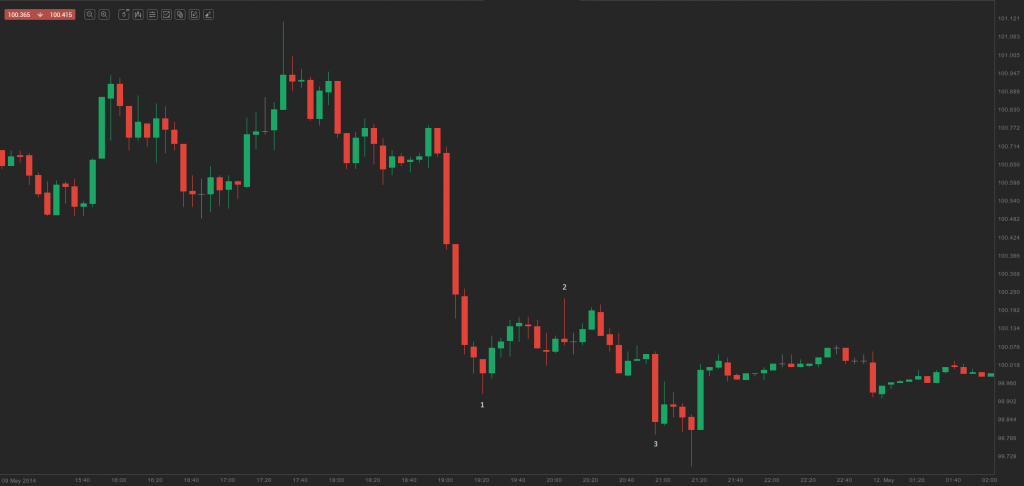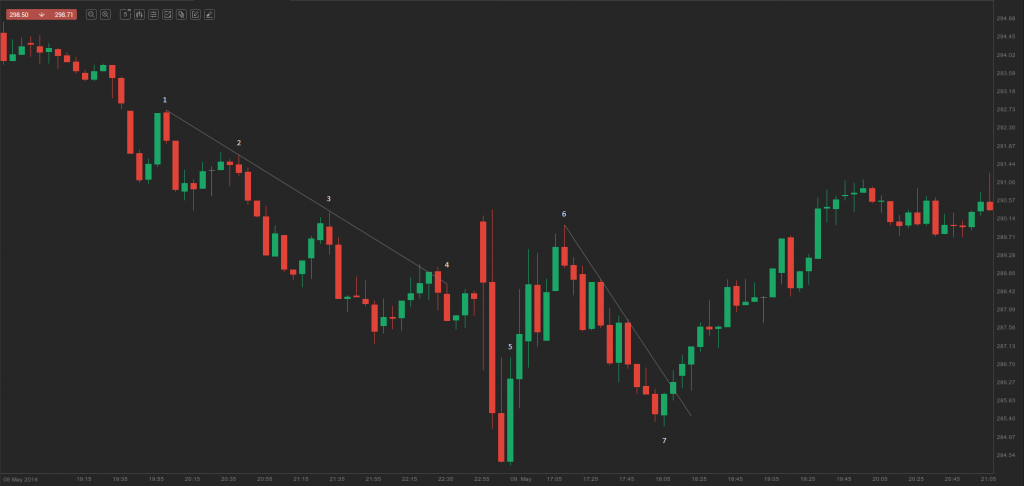Trend reversal tests
This lesson will cover the following
- Tests of prior trend extremes can be two-legged
- The case with spikes
All trends end with a reversal (a move against the trend, which breaches a trend line), after which the market tests the last extreme level of the trend. This test usually overshoots the prior trend extreme (a lower low in a new uptrend and a higher high in a new downtrend), or undershoots this extreme (a higher low in a new uptrend and a lower high in a new downtrend). An overshoot can be viewed as the final leg of the prior trend, because it leads to an even more extreme level in that trend. An undershoot, on the other hand, can be considered as a pullback from the first leg of the new trend.
Tests of prior trend extremes can be two-legged
A test may consist of two legs. Let us have an example. In the area close to the high of the market, following a breach of the trend line, the price will very often surge once again in an attempt to reach even higher levels. However, the bears again manage to overpower the bulls around the level, where they did so earlier. This way buyers have tried twice to push the price higher and both attempts failed. As we already said, whenever the market attempts to do one and the same thing twice and does not succeed, then it will usually attempt to do the opposite.
Because a countertrend move, following a breach of a trend line, demonstrates two legs, in case a reversal to the upside tests the low of the downtrend with a higher low, the latter may also mark the beginning of the second leg. However, in case the test occurs with a lower low, the latter may mark the beginning of the first leg, while after this first leg a pullback may follow and then a second leg. In the case with a reversal to the downside a lower high test would be the beginning of the second leg, while a higher high test would be the beginning of the first leg.
The case with spikes
Sometimes the countertrend move may be of considerable strength, a spike, which does not have pullbacks. This spike may appear to serve as a trend reversal, but after that a resumption of the original trend may follow. If the resumption is comprised by enough bars and corrects a large portion of the spike, some traders may begin to wonder whether this is a failed reversal and not a pullback, following an actual (successful) reversal. Extremes of most sharp moves, which are followed by deep corrections, are eventually tested and even surpassed.
Let us have the following situation. A huge move to the downside occurs, followed by a correction up, which retraces a large portion of the spike. This move is usually accompanied by another sell-off, which tests the bottom of the first spike. From this point on the original trend may resume (a double bottom bull flag will be formed), the reversal of the original trend may continue to the downside, or trading may become sideways.
The chance of a test is far greater, if the sudden move occurs within a trading range or it is in the same direction as the original trend (a spike down during a downtrend). A test is not likely to occur, if it involves a countertrend move during a strong trend (a sharp spike up during a strong downtrend may only trap buyers and not be tested).
There are climax reversals, which are not necessarily followed by a pullback, testing the prior extreme. This may be the case with an overshoot of the trend channel line and a reversal. These climaxes can be seen often on smaller time frames. For instance, the 1-minute chart may show several climaxes each trading day.
A sequence of trend bars with large bodies, small wicks and little overlap between them, followed by a pullback, has almost always a test of its prior extreme level. On the 5-minute chart of Crude Oil above bar 3 low tested and exceeded the low of bar 1, but no actual reversal followed and the down move lasted for a few more bars.
On the 5-minute chart of AMZN above bar 5 low tested and exceeded the prior low in the bear trend. A test by a lower low usually leads to at least two-legged countertrend move and that is what occurred in our case. There were two moves to the upside from bar 5 and bar 7. Bar 7 was a higher low, which came after the bear trend line from the prior trading day was broken. As it was a higher low, bar 7 marked the start of the second leg and the completed leg itself marked the end of the up move. Bar 5 was a lower low after a key bear trend line breach, so it was a “possible” reversal of the underlying trend.

